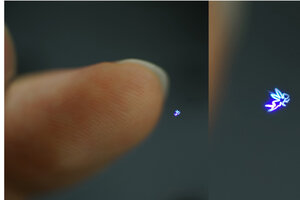Ever wanted to play with a hologram? Now you can.
Researchers in Japan have discovered how to safely project 3D images we can touch and play with.

Designers used rapid-speed lasers and mirrors to project these interactive "fairy lights."
Digital Nature Group
As if virtual reality headsets and computer-enabled glasses weren’t enough, now researchers in Japan are paving the way for a phenomenon we’ve long dreamed about: interactive holograms.
Designers at the Digital Nature Group at Japan’s University of Tsukuba were able to create the 3D images by using scanners; mirrors; and rapid-speed, high-intensity lasers.
Firing these lasers, emitted by the femtosecond – that is, a quadrillionth of a second – produces safer results than those generated by the nanosecond, the lab said on its website.
It is the first time this kind of imagery has been developed that isn’t harmful to the human touch, according to Mashable. Previous studies with similar plasma-induced technology have never been able to yield such high-resolution images, and tended to burn at the touch, Chunlei Guo, professor of optics and physics at the University of Rochester, told PopSci.com.
So what does touching a hologram feel like? Sandpaper, according to the project’s principal investigator Yoichi Ochiai.
In its demonstration video, the team also created playful projections to demonstrate their interactive capabilities, such as ticked-off checkboxes and broken hearts floating in real space.
Since its popularization in science fiction, particularly the iconic Star Wars scene in which Princess Leia is projected in an ethereal glow, holography has been a goal for researchers.
In April, a company hoping to figure out how to let viewers ditch 3D glasses unveiled a mobile display that allows users to watch holographic images from 64 different angles – the first of its kind, its CEO David Fattal told Reuters. (The company also credits its name, Leia, to the popular Star Wars franchise.)
It’s also seeped increasingly into the mainstream as projections of Stephen Hawking, Michael Jackson, Tupac Shakur, and even Larry King have popped up at concerts and conferences to wild fanfare.
Virtual projections are especially popular when it comes to “resurrecting” dead pop artists. A Rolling Stone poll that asked its readers which 10 artists should return as holograms indicated Kurt Cobain, Freddy Mercury, and John Lennon as top picks.
In recent years, US airports have employed virtual assistants to explain rules to travelers before passing through security, and physicists have even hypothesized that the universe is one massive hologram.
“I want to be a hologram,” Forbes contributor and leadership consultant John Baldoni wrote this week. He praised how the rise of the “HumaGram,” a 3D interactive hologram not unlike those in airports, had awarded a jet-setting motivational speaker valuable time and street cred.
While companies are still building the technology to publicly market holograms, this latest invention in Japan marks a breakthrough in making them more accessible, and will allow the team to use it for other aerial holographic interfaces, reported Mashable.
The programming will be demonstrated at the Siggraph exhibition in Los Angeles in August.

